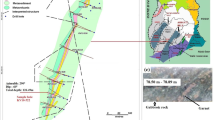Abstract
Optical microscopy, X-ray diffraction (XRD), and back-scattered electron imaging (BSE) have been used to determine the mineralogical composition of the uraniferous iron and manganese oxides and the associated U-minerals hosted in biotite granite that occurred north east Gabal El Sela area south Eastern Desert, Egypt. These mineralizations were found as veinlets fractures filling associated with strongly kaolinitic alteration of the coarse-grained biotite granite. XRD determined that the geothite mineral form the main constituent of uraniferous iron oxide in addition to tapiolite, and kaolinite minerals, where as uraniferous manganese oxide composed of pyrolusite, ramsdellite, and cryptomelane. BSE confirmed that the associated uranium minerals represented by uranothorite, kazolite, and zentime in addition to columbite-bearing minerals. Uranothorite and columbite-bearing minerals are the most abundant minerals in this mineralization. Petrographically, biotite granite is composed mainly of quartz, in addition to K-feldspars, biotite and muscovite with minor zircon, garnet, apatite, uranium-rich thorite and iron oxide. Petrochemical studies and tectonic discrimination diagrams for this granite reveal that they are classified as granite to alkali feldspar granite, originated from calc-alkaline magma having peraluminous nature and developed in within-plate tectonic environment. Field radiometric measurements revealed the localization of two high radiometric anomalies associated with iron and manganese oxides, within this anomaly uranium content range from 65 to 85 ppm. Alpha Track-etch Detectors of radon gas registrations revealed high track density reach up to 15,448.7 Bq/m3.


























Similar content being viewed by others
References
Abd El-Naby HH, Dawood YH (2008) Natural attenuation of uranium and formation of autunite at the expense of apatite within an oxidizing environment, south Eastern Desert of Egypt. J Appl Geochem. doi:10.1016
Abdel Meguid AA, Ammar SE, Ibrahim TMM, Ali Kh G, Shahin HA, Omer SA, Gaafar IME, Masoud SM, Khamis AA, Haridy MH, Kamel AI, Mostafa BM, Abo Donia A, Abdel Gawad AE, Aly EM (2003) Uranium Potential of Eastern Desert Granites, Egypt, Internal Report
Assaf HS, Attawiya MY, Ibrahim ME, Ammar SE, Shalaby MH (1999) Geological, geochemical and mineralogical studies on the radioactive minerals occurrence at Qash Amir area, South Eastern Desert, Egypt. J Mineral Soc Egypt 11:135–156
Ball J (1912) The geography and geology of south eastern Egypt. Geol. Surv., Cairo. P. 394
Bassiuny FA (1957) Mineral prospecting in Elba area during seasons 1956–1957,Geol. Surv., Egypt, (internal report in Arabic)
Basta EZ, Saleeb WS (1971) Mineralogy of the manganese ores of Elba area south Eastern Desert, U. A. R. J Geol 15(1):29–48
Durrani SA, Ilic R (1997) Radon measurements by etched track detectors. World Scientific, London
El Afandy AH, Bakhit FS, Yonan AA, Saleh GH (2002) Geology, geochemistry and radioactivity of Sela–Qash Amir granites, south eastern desert, Egypt. Egypt Mineral 14:117–140
El Alfy Z, Bagddady M, Awaga G, Morsei A, Ramadan T, Abdallah MA (1994): Geo- chemical exploration of Elba–Gerf area south Eastern Desert, Egypt, Geol. Surv., Cairo (unpublished report)
El Shazly EM, Saleeb GS (1959) Contribution to the mineralogy of Egyptian manganese deposits. Econ Geol 54(5):873–888
Fitches WR, Graham RH, Hussein IM, Ries AC, Shackleton RM, Rice RC (1983) The Late Proterozoic ophiolite of Sol Hamed, NE Sudan Precambrian Research, V. 19, PP. 385 – 41, Elsevier Amsterdam
Gaafar MI, Ghazala HH, Ibrahim TM, Ammar SE (2006) Gamma ray spectrometry studies for a promising vein type uranium mineralization, South Eastern Desert, Egypt. In: Proc. 4th Internat.Symp. Geophysics, Tanta, Egypt, pp. 445–456
Hume WF (1935), (1937) Geology of Egypt. II. The fundamental Precambrian rocks of Egypt and Sudan : Part I, The metamorphic rocks : 1–300, Part II, The later plutonic and minor intrusive rocks : 301–688, Part III, The minerals of economic value : 689–900, Geol. Surv. Egypt
Hussein IM, Nur SM, Khogali O, Gabralla AF, Ali SM, Razvalaev A, Balkhanov VV (1973) Geology of the Halaib-northern Dungunab area, Red Sea Hills. Preliminary report for the geological and mineral exploration project, Red Sea Hills, Port Sudan
Ibrahim TMM, Cuney M, Ali KG, Abdel Meguid AA, Gaffar IM, Shahin H, Omar SA, Masoud SM, Haridy HMM (2005) The U-fertility Criteria Applied to El Sela Granite, South Eastern Desert, Egypt. International Symp. Uranium Production and Raw Materials for the Nuclear Fuel Cycle, IAEA, Vienna, Austria, 20–24 June 2005, pp. 1103
Ibrahim TMM, Amer TE, Ali KG, Omar SM (2007) Uranium potentiality and its extraction from El Sela shear zone, south Eastern Desert Egypt. Sci Fac Sci Minufia Univ XXI:1–18
Irvine TN, Baragar WRA (1971) A guide to the chemical classification of the common volcanic rocks. Can J Earth Sci 8:523–548
Khalaf IM (2005) Geology of the area around G. Qash Amir with special emphases on the granitic rocks, south Eastern Desert, Egypt. Egypt J Geol 49:49–64
Khan HA, Quresh AA (1994) Solid state nuclear track detection: a useful geological/geophysical tool. Nucl Geophys 8:1–37
Maniar PD, Piccoli PM (1989) Tectonic discrimination diagrams of granitoids. Geol Soc Am Bull 101:635–643
Middlemost EAK (1985) Magma and magmatic rocks, Longman Group Limited Essex
Nasr BB, Youssef M (1995) New occurrences of Tertiary alkaline rocks at Gebel Elba area South Eastern Desert, Egypt. Ann Geol Surv XX:871–873
Nazaroff WW, Nero AV (1988) Radon decay products in indoor air. Wiley, New York
Pearce JA, Harris NB, Tindle AG (1984) Trace element discrimination diagrams for the tectonic interpretation of granitic rocks. J Petrol 25:956–984
Saleeb GS, Hilmy ME, Awad NT (1977) The barite vein deposit of Elba Egypt. Bull NRC Egypt 2:94–106
Takla MA, Basta EZ, El-Sharkawi MA, Fawzie E (1976) The Mineralogy of some wolframite veins from Egypt. Bull. Faculty of Science, Cairo, Univ. No. 49
Author information
Authors and Affiliations
Corresponding author
Rights and permissions
About this article
Cite this article
Shahin, H.A.ER.A. Occurrence of uraniferous iron and manganese oxides in biotite granite North East Gabal El Sela area, South Eastern Desert, Egypt. Arab J Geosci 6, 2245–2259 (2013). https://doi.org/10.1007/s12517-011-0508-z
Received:
Accepted:
Published:
Issue Date:
DOI: https://doi.org/10.1007/s12517-011-0508-z




